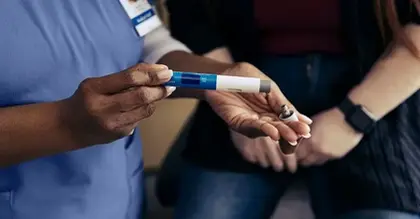Note: This document contains side effect information about betamethasone topical. Some dosage forms listed on this page may not apply to the brand name Luxiq.
Applies to betamethasone topical: topical application cream, topical application lotion, topical application ointment, topical application spray. Other dosage forms:
- topical application cream, topical application foam, topical application lotion, topical application ointment
Serious side effects of Luxiq
Along with its needed effects, betamethasone topical (the active ingredient contained in Luxiq) may cause some unwanted effects. Although not all of these side effects may occur, if they do occur they may need medical attention.
Check with your doctor immediately if any of the following side effects occur while taking betamethasone topical:
More common
- Burning or stinging
- itching at the application site
Less common
- Blistering, burning, crusting, dryness, or flaking of the skin
- cracking or tightening of the skin
- dry skin
- flushing or redness of the skin
- irritation
- itching, scaling, severe redness, soreness, or swelling of the skin
- thinning of the skin with easy bruising, especially when used on the face or where the skin folds together (eg, between the fingers)
- unusually warm skin
Rare
- Blistering, peeling, or loosening of the skin
Incidence not known
- Blindness
- blurred vision
- change in vision
- decreased vision
- eye pain
- headache
- loss of vision
- nausea
- redness and scaling around the mouth
- tearing
- vomiting
Other side effects of Luxiq
Some side effects of betamethasone topical may occur that usually do not need medical attention. These side effects may go away during treatment as your body adjusts to the medicine. Also, your health care professional may be able to tell you about ways to prevent or reduce some of these side effects.
Check with your health care professional if any of the following side effects continue or are bothersome or if you have any questions about them:
Less common
- Raised, dark red, or wart-like spots on the skin, especially when used on the face
Rare
- Burning, itching, and pain in hairy areas, or pus at the root of the hair
Incidence not known
- Acne or pimples
- burning and itching of the skin with pinhead-sized red blisters
- increased hair growth on the forehead, back, arms, and legs
- lightening of normal skin color
- lightening of treated areas of dark skin
- reddish purple lines on the arms, face, legs, trunk, or groin
- softening of the skin
For Healthcare Professionals
Applies to betamethasone topical: topical cream, topical foam, topical gel, topical lotion, topical ointment, topical spray.
General
The most commonly reported side effects were pruritus, burning, itching, irritation.
Hypersensitivity
Rare (less than 0.1%): Hypersensitivity
Endocrine
Frequency not reported: Cushing's syndrome[Ref]
Dermatologic
Common (1% to 10%): Pruritus
Uncommon (0.1% to 1%): Folliculitis, skin infections (including bacterial, fungal and viral skin infections)
Frequency not reported: Dryness, hypertrichosis, acneiform eruptions, hypopigmentation, perioral dermatitis, allergic contact dermatitis, maceration of the skin, secondary infections, skin atrophy, striae, miliaria[Ref]
Local
Uncommon (0.1% to 1%): Application site pain
Frequency not reported: Burning, itching, irritation[Ref]
Ocular
Rare (less than 0.1%): Eye disorder
Postmarketing reports: cataracts, glaucoma, increased intraocular pressure, central serous chorioretinopathy[Ref]
Metabolic
Frequency not reported: Hyperglycemia
Renal
Frequency not reported: Glucosuria
Other
Rare (less than 0.1%): Rebound effect




